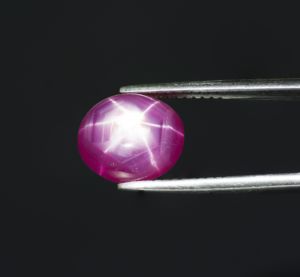There are many popular gemstones but none as famous as the ruby. Its color is unrivaled: It burns like a red-hot flame that never goes out. For centuries, many monarchs and rulers of civilizations coveted it. Not only is the glowing red gem stunning, but it is highly durable. This combination makes it ideal for daily wear in an engagement ring. A ruby ring isn’t just the perfect romantic gift—it’s the ultimate symbol of love.
Its name comes from the Latin word ‘ruber’, which translates to ‘red’. It is the color of our strongest emotions—passion, anger, love, and fury—and the blood flowing through our veins. It is thought to connect to the heart and your deepest desires. In the past, medieval Europeans believed rubies brought wisdom, wealth, success in love, and power. It might explain why many queens and empresses of European nations such as Spain, England, Austria, and France wore it. Even today, ruby remains fashionable in the upper classes and royal circles of the western world.
If your heart is set on a ruby engagement ring, then you should know certain factors that can help you pick the perfect ruby. Let us help you go through all you need to know.
How important is color in a ruby ring?
Like other colored gemstones, color is crucial when it comes to the ruby. It is the red variety of corundum—the same mineral that sapphire is made from. At its purest, corundum is colorless. Ruby has the distinguished honor of having its own name: All other corundum colors are called ‘sapphire’. This is important because other red stones exist. But only rubies have that distinguishable rich shade of lively red to slightly purple red. Until the twentieth century, nearly all of the world’s rubies came from Burma. It was common to mistake other red gems for rubies. Since ruby has different shades of red, the debate continues about how to differentiate between ruby and pink sapphire.
The ideal ruby is neither too light nor too dark. If it is too light, it might be considered a pink sapphire. If it is too dark, that negatively affects its brightness. It also has secondary colors such as pink, orange or purple. These can dramatically affect the value of the stone: the stronger the orange or purple tones, the less valuable it becomes. The intense pigeon blood red is the most desirable color for rubies. They do not have secondary colors and are extremely rare, making them extremely expensive.
Ruby is hard to beat. If you are looking for a ruby ring, keep in mind that you should look at it in good light to see what color it is. This will affect the price you pay.
How important is clarity for a ruby ring?
But, don’t forget to look at other factors too: Clarity matters greatly. If the inclusions blemish the stone’s brilliance or transparency, the value drops quite significantly. When it comes to faceted rubies, the fewer the inclusions and the clearer the gem, the higher the price. In cabochons, which are generally less expensive, some inclusions can enhance the ruby’s appearance. Criss-crossing needle-like inclusions create an attractive star-like effect known as asterism. It appears on the surface as a three or six-point star. These stones are cut in a way to highlight the star (hence the term ‘star ruby’). If you find one of these, you have a great buy on your hands. But know that if you choose a ruby with asterism, you have to be prepared to stretch your budget a little.

How do enhancements affect rubies and their pricing?
Treatments and enhancements are an industry practice. They can strengthen the color and clarity of colored gemstones. Most rubies are treated in some manner. Heat treatment can eliminate the secondary colors to enhance a ruby’s vivid redness. It can also lighten it and remove tiny inclusions. As a rule of thumb, expect your ruby to have been heat-treated. In most instances, this will not lower the gem’s value. In low-grade ruby stones, some cavities and surface-reaching fractures are filled with glass. This makes it appear more transparent. It also increases the stone’s vulnerability to damage. That’s why glass-filled rubies have a lower value than heated rubies.
Before you hand over your money, feel free to ask about how your ruby was treated. After all, you want peace of mind and assurance for your ruby ring.
How do you choose the correct size ruby?
Rubies are sold based on a price-per-carat basis. What’s more, its size plays a significant role in its pricing: It is quite rare to find a ruby larger than one or two carats, which increases its value . The bigger the stone and the finer the quality, the higher the price (i.e. a four carat ruby of similar color and clarity will cost quite a bit more on a per carat basis than a similar 2 carat stone). For instance, if a 1-carat ruby has a price tag of $1,000, you can expect a 5-carat ruby of the same quality to cost ten times as much!
In the past, 20-carat stones were exclusive to Burmese kings. Even though large rubies do exist today, they are bought mainly by the wealthy. Nevertheless, the size does not affect its radiance. A 1-carat ruby for your engagement ring is just as glamorous as it would be for royalty.
What is the best shape and cut for a ruby ring?
Rubies come in different cuts and shapes. Round, princess, or pear cuts can highlight its light and brilliance. Cushion cuts can enhance its red robustness, and cabochon cuts can draw out any asterisms. While larger high-quality stones come available in triangular or emerald cuts, many prefer the mixed cut.
Most rubies come cut in a style suited to their country of origin. You can get the ruby re-cut but will lose more carats and even the size. If your heart is set on a specific cut, narrow your options. Keep an open mind—you never know what you might find.
One stone or many accent stones?
It depends entirely on how much your budget can afford. Since big rubies are rare, small ruby accent stones can enhance the overall colorfulness of your ring. You can also pair it with colorless diamonds to add fire to the ruby’s red heat. Get creative with how you pair the stone for the ring that symbolizes your love.
What metal goes well with RUby rings?
Think about the effect you are creating. White gold paired with ruby is chic and fashionable. Yellow or rose gold and ruby has a vintage, classic appeal. Does it match your partner’s style and sensibilities? Look around for choices before you decide.
A ruby engagement ring or a ruby promise ring?
Given its price, a ruby represents a significant commitment. Consider a synthetic ruby if you are looking for a ruby promise ring or an engagement ring alternative that won’t break the bank. A synthetic ruby has the same chemical structure as a natural ruby except it is created in a lab. It is generally flawless and a cost-efficient substitute and is certainly not a fake ruby or a garnet might be a less expensive option for a ‘red’ gemstone.
How to care for your ruby ring?
Ruby (corundum) ranks 9 on the Mohs scale. It is a tough stone with no cleavage. To clean your ring, use warm soapy water. If your stone is cavity-filled or fracture-filled, only clean it with a damp cloth. With the proper care, a ruby ring can last you for a lifetime.
Is a ruby ring worth it?
Rubies fetch amongst the highest per-carat price of any colored stone in the market. Burmese rubies, especially, are rare and more expensive—their stunning quality makes it the best of the best. This is your ring if money is no concern.
Lately, though, Mozambique rubies have been giving Burmese rubies a run for their money. Fine in quality and splendid in color, they are a great alternative to a Burmese ruby. If you are looking for a cheaper stone, though, you should consider an Indian ruby. Cost-wise, be prepared to spend anywhere between $100 to over $1,000 (per carat). Whatever the bill adds up to, though, it is worth seeing your partner’s heart melt when they see you propose with a ruby ring. It lets them know how much you mean to them. This July birthstone is the queen of all gemstones. More than that, it conveys a heartfelt signal that you are committed to your partner and are enthusiastic about your shared goals. It says that you are confident that you have found someone precious and rare to keep forever in your life. What better way to show that than with a ruby ring?
